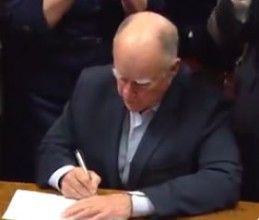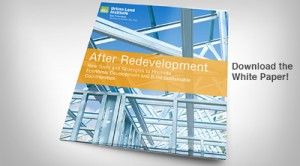Gov. Brown rebuilds redevelopment
by John | September 30, 2014 11:05 am
 [1]Reversing his 2011 abolition of redevelopment, on Monday Gov. Jerry Brown signed into law two bills that will revive it, Senate Bill 628 and Assembly Bill 229[2]. He also vetoed a third redevelopment measure, AB2280[3], he believed went too far by codifying an anti-poverty program into redevelopment law.
[1]Reversing his 2011 abolition of redevelopment, on Monday Gov. Jerry Brown signed into law two bills that will revive it, Senate Bill 628 and Assembly Bill 229[2]. He also vetoed a third redevelopment measure, AB2280[3], he believed went too far by codifying an anti-poverty program into redevelopment law.
Property rights advocates opposed the trio of bills as bringing back eminent domain abuses and taxpayer-funded corporate handouts.
“Since redevelopment’s abolishment in 2011, the Redevelopment Lobby has been advocating for a replacement that would bring politically connected developers back to the public money trough,” said Nick Mirman, a grassroots activist with the California Alliance to Protect Private Property Rights, an influential property rights group that recently released a radio ad campaign [4]against the measures. “If signed, these redevelopment bills will invite a return to the era of rampant eminent domain abuse and corporate welfare.”
2011: Brown abolished redevelopment
Brown’s signatures reversed his 2011 decision to abolish the state’s redevelopment agencies. At that time, Brown gained $1.5 billion in redevelopment funds to close the state’s budget gap. And he said the state needed to move away from redevelopment agencies.
“Some of this redevelopment has been going on for 20, 30, even 40 years,” Brown said, according to the LA Times[5]. “We’ve got a lot of the redevelopment thrust, and now we’re going to have to move away from it or we’re going to have to cut more deeply.”
And just two years ago, City Journal reported, Brown vetoed [6]“a slate of six bills that would have revived, in one form or another, California’s redevelopment agencies.”
AB229: Infrastructure and Revitalization Financing Districts
AB229[7], authored by Assemblyman John A. Perez[8], D-Los Angeles, would allow local governments to create Infrastructure and Revitalization Financing Districts[9] to revive old military bases. According to the Legislative Counsel’s digest, these districts could issue 30 years of debt with the approval of two-thirds of voters in the district.
The California Alliance to Protect Private Property Rights contended, “IRFDs will have all the unchecked powers granted to Redevelopment Agencies[10], including the unrestricted power of eminent domain to forcibly seize homes and small businesses on behalf of politically connected developers.”
That position is supported[11] by the California Taxpayers Association.
SB628: Redevelopment 2.0
Earlier this year, UT San Diego columnist Steven Greenhut[12] warned the issue was “back with a vengeance[13].” He is the author of a book on redevelopment, “Abuse of Power: How the Government Misuses Eminent Domain[14].”
“Redevelopment offered wide latitude to publicly fund private development projects — and this bill could make it even wider,” he wrote. “Redevelopment revivalists have promoted the use of Infrastructure Financing Districts as a partial replacement for the defunct agencies. This bill that puts those districts on steroids.”
SB628[15], authored by state Sen. Jim Beall[16], D-San Jose, would revive redevelopment agencies under a new name, “Enhanced Infrastructure Financing Districts.” These districts would be allowed to “finance public capital facilities or other specified projects of community-wide significance” with the approval of 55 percent of voters in the district, according to the legislative summary[17].
 [18]
[18]
The influential Howard Jarvis Taxpayers Association called the proposal “Redevelopment 2.0 without any protections whatsoever.”
AB2280: Community Revitalization and Investment Authority
The only bill vetoed by Brown was Assembly Bill 2280[19], by Assemblyman Luis Alejo[20], D-Salinas. The legislation would have allowed local governments to create[21] a “Community Revitalization and Investment Authority in a disadvantaged community to fund specified activities.”
According to the California Planning and Development Report[22], “AB 2280 would revive redevelopment-style tax-increment financing in narrowly chosen urban areas, with 25% affordable housing set-asides. Those provisions are more reassuring to housing and local-government advocates but more likely to trigger the governor’s opposition to former redevelopment mechanisms and his skepticism toward housing affordability restrictions.”
In his veto message[23], Brown said the bill went too far. “I applaud the author’s efforts to create an economic development program, with voter approval, that focuses on disadvantaged communities and communities with high unemployment,” he wrote. “The bill, however, unnecessarily vests this new program in redevelopment law. I look forward to working with the author to craft an appropriate legislative solution.”
Redevelopment: History of abuses
Redevelopment agencies, which promise to revive blighted areas, have a long history of abusing property rights and granting sweetheart deals to developers. In the landmark case, Kelo v. City of New London, the U.S. Supreme Court allowed the city to seize the homes and property of Susette Kelo and her neighbors in Connecticut in order to provide a corporate welfare package to the pharmaceutical giant Pfizer, Inc.
“While Ms. Kelo and her neighbors lost their homes, the city and the state spent some $78 million to bulldoze private property for high-end condos and other ‘desirable’ elements,” the Wall Street Journal[24] observed in 2009. “Instead, the wrecked and condemned neighborhood still stands vacant, without any of the touted tax benefits or job creation.”
Before they were abolished in 2011, California’s redevelopment agencies were no better than those in New London.
“California’s redevelopment agencies are some of the worst perpetrators of eminent domain abuse in the nation,” said Christina Walsh of the Institute for Justice in 2011 as redevelopment was being abolished; the institute represented Kelo. “Until state legislators abolish these agencies, no private property owner in California is safe.”
Now redevelopment is back.
- [Image]: http://calwatchdog.com/wp-content/uploads/2014/08/brown-signing-water-bond.jpg
- Senate Bill 628 and Assembly Bill 229: http://gov.ca.gov/news.php?id=18740
- AB2280: http://www.leginfo.ca.gov/pub/13-14/bill/asm/ab_2251-2300/ab_2280_cfa_20140825_195904_asm_floor.html
- released a radio ad campaign : http://www.calnewsroom.com/2014/09/26/property-rights-group-urges-brown-to-veto-redevelopment-2-0/
- according to the LA Times: http://articles.latimes.com/2011/jan/27/local/la-me-jerry-brown-20110127
- vetoed : http://www.city-journal.org/2012/cjc1120sg.html
- AB229: http://www.calpropertyrights.com/wp-content/uploads/2011/06/9.23.14-AB-229-Veto-Ltr.pdf
- John A. Perez: http://www.calnewsroom.com/tag/john-perez/
- Infrastructure and Revitalization Financing Districts: http://leginfo.legislature.ca.gov/faces/billHistoryClient.xhtml#
- Redevelopment Agencies: http://www.calnewsroom.com/tag/redevelopment-agencies/
- supported: http://www.calnewsroom.com/2014/09/26/property-rights-group-urges-brown-to-veto-redevelopment-2-0/
- Steven Greenhut: http://www.calnewsroom.com/tag/steven-greenhut/
- back with a vengeance: http://www.utsandiego.com/news/2014/sep/08/redevelopment-redux-triggers-local-tax-increases/
- Abuse of Power: How the Government Misuses Eminent Domain: http://www.amazon.com/Abuse-Power-Government-Misuses-Eminent/dp/1931643377/ref=sr_1_1?s=books&ie=UTF8&qid=1412093510&sr=1-1&keywords=greenhut+abuse+of+power
- SB628: http://www.calpropertyrights.com/wp-content/uploads/2011/06/9.23.14-VETO-SB-628.pdf
- Jim Beall: http://www.calnewsroom.com/tag/jim-beall/
- legislative summary: http://www.leginfo.ca.gov/pub/13-14/bill/sen/sb_0601-0650/sb_628_bill_20140905_enrolled.htm
- [Image]: http://calwatchdog.com/wp-content/uploads/2013/12/After-Redevelopment1.jpg
- Assembly Bill 2280: http://leginfo.legislature.ca.gov/faces/billNavClient.xhtml;jsessionid=1b484608fa0eb2163b6c6a1e3a14
- Luis Alejo: http://www.calnewsroom.com/tag/luis-alejo/
- to create: http://www.lachamber.com/clientuploads/LUCH_committee/AB2280_PolicyBrief.pdf
- California Planning and Development Report: http://www.cp-dr.com/node/3563
- veto message: http://gov.ca.gov/docs/AB_2280_Veto_Message.pdf
- Wall Street Journal: http://online.wsj.com/news/articles/SB10001424052748704402404574527513453636326?
Source URL: https://calwatchdog.com/2014/09/30/gov-brown-rebuilds-redevelopment/